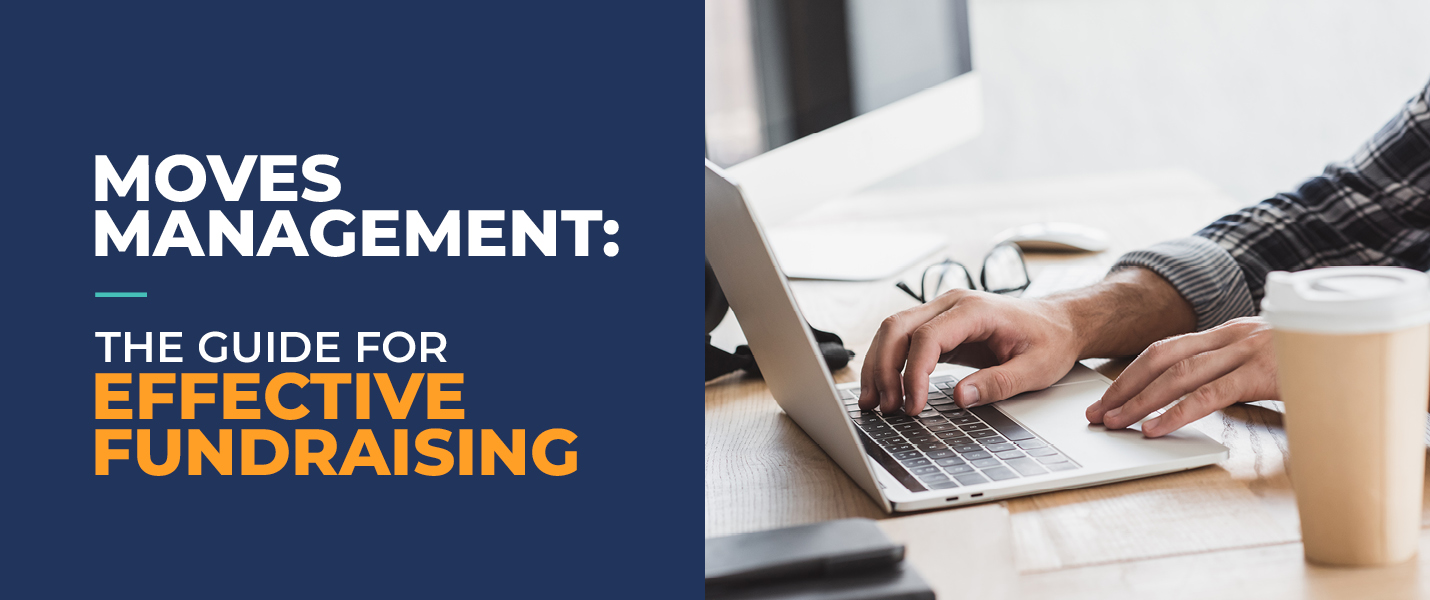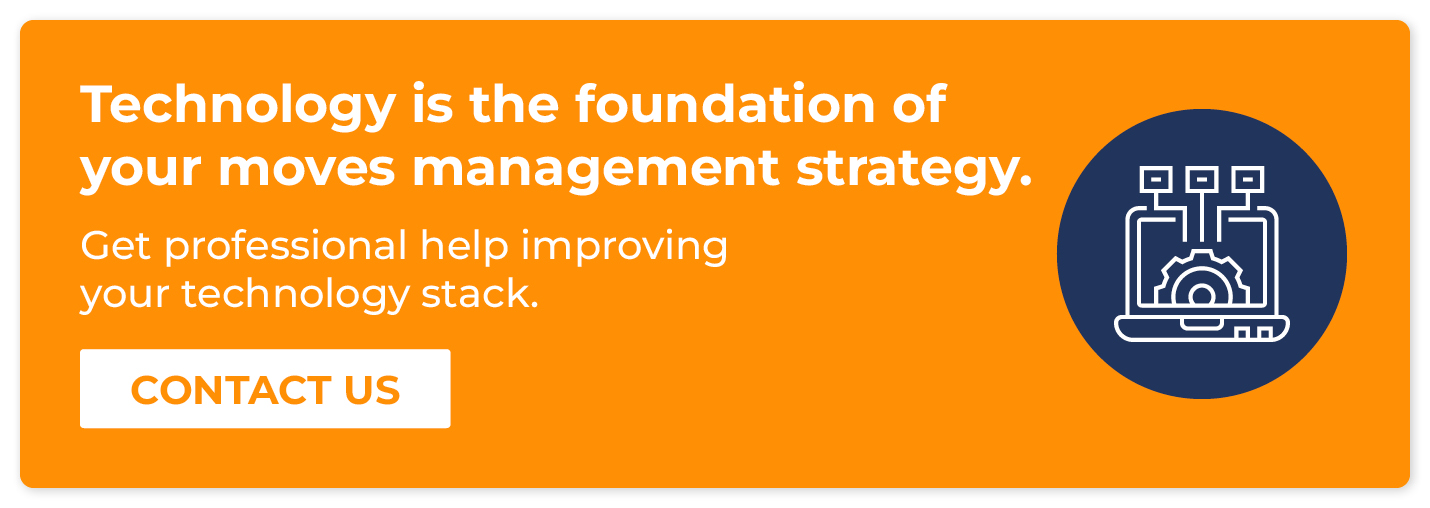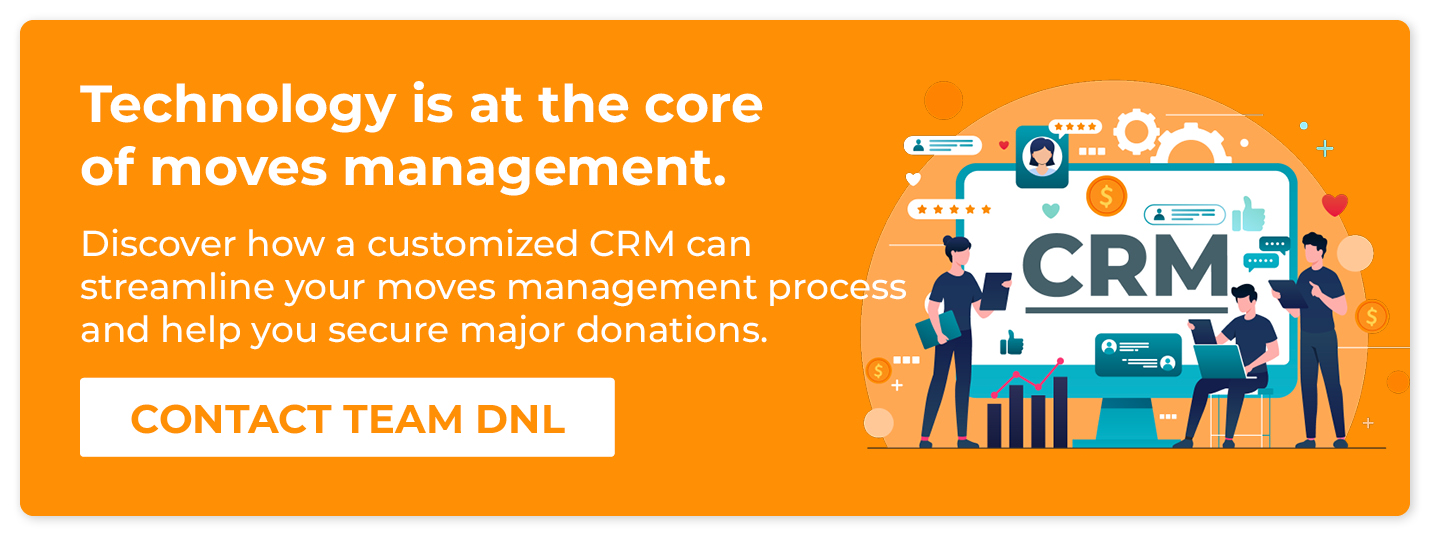Securing major gifts is a strategic effort. Each step you take with a prospect, from initial outreach to receiving a gift, needs to be carefully planned for and tracked. In the nonprofit world, this tracking process is referred to as moves management.
As with other fundraising strategies, technology plays a key role in determining your success. At DNL OmniMedia, we help nonprofit organizations use their technology to track donor data, cultivate supporter relationships, and secure major gifts.
To help you develop a moves management strategy and get your technology prepared for major gifts cultivation, we will cover the following:
- Covering the Basics of Moves Management Fundraising
- Identifying Moves Management Data Sources
- A Moves Management Template For Your Strategy
- Moves Management Best Practices
Earning major gifts takes time, but a solid strategic infrastructure for moves management can streamline your prospecting and cultivation process. This enables you to raise more funding and avoid rebuilding processes from scratch each time you seek out a major gift.
Before outlining our recommended moves management process, we will first start with moves management essentials.
Covering the Basics of Moves Management Fundraising
What is moves management?
To understand moves management, you first need a working definition of “moves.”
Moves are the various connections and steps a nonprofit takes to usher a donor toward giving.
You might have encountered this concept before in for-profit contexts. Salespeople at businesses carefully track their potential buyers through the sales cycle so they know exactly when the right time is to push them toward converting. That said, some common examples of nonprofit moves include:
- Meeting with major gift prospects
- Seeking feedback from prospects regarding an upcoming campaign
- Making major gift asks
With this definition of moves, we can now define moves management.
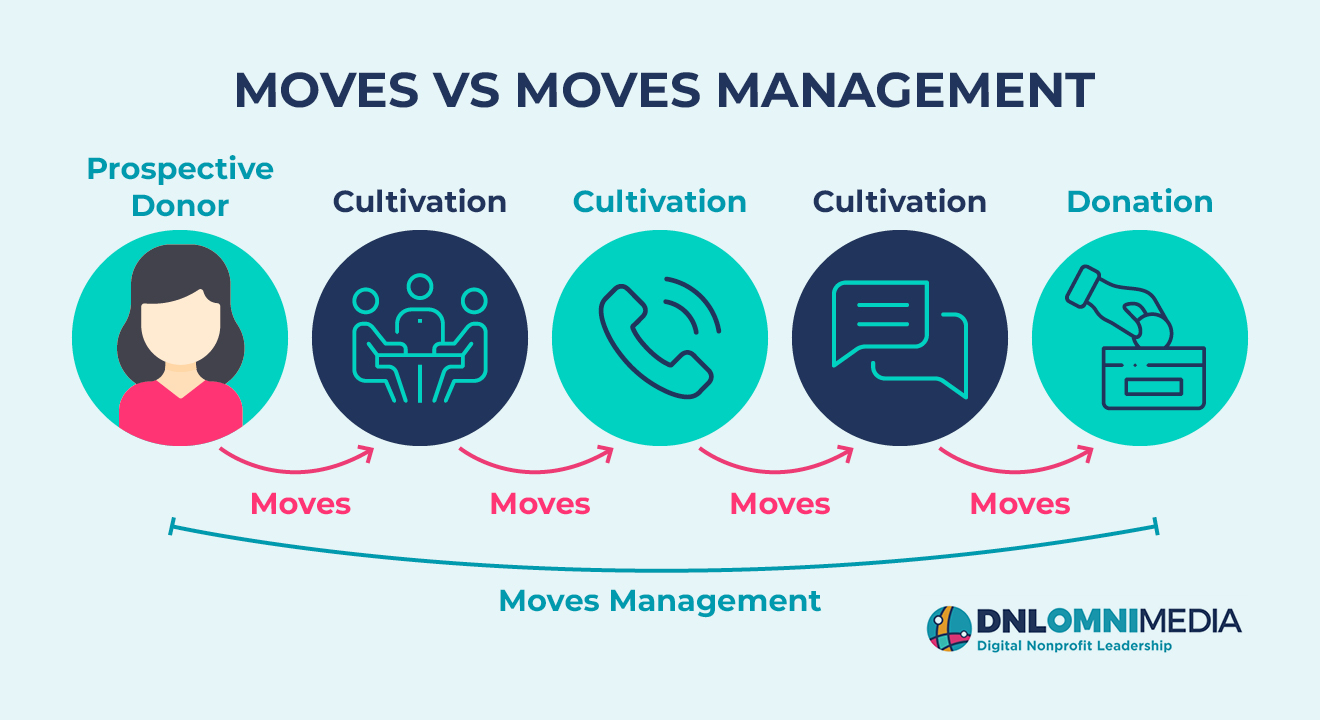
Moves management is the process of tracking all moves taken with a donor to control the stewardship and cultivation of major donors.
The goal of moves management is to give major gift officers a clearer view of:
- Where each major gift prospect is currently located in the giving lifecycle
- Clear steps forward that will ensure the highest chance of success in drawing that prospect further down the gift funnel
Effective moves management is built on the donor and gift lifecycle. With knowledge of where each prospect is in the cycle, major gift officers can better personalize their interactions with potential donors and more efficiently cultivate major gifts.
What is this strategy used for?
While theoretically moves management can be used for donors at any level, the amount of time and effort that goes into moves management makes it most effective for stewarding major gift prospects.
This could mean cultivating large gifts for the year-end season, capital campaigns, planned giving programs, or other major donation opportunities. The key is that the extensive moves management process is generally used to secure these larger gifts.
If your nonprofit is instead currently looking to secure small, one-time gifts, you likely do not need to create a comprehensive moves management strategy.
Identifying Moves Management Data Sources
Securing major gifts relies on building relationships with major giving prospects. When a major gift officer has a solid personal connection with a giving candidate, they can better determine when is the right time to move the relationship forward.
However, to identify these major giving prospects and begin the relationship-building process, your nonprofit first needs the necessary data to assess and stay updated on donors. Here are a few tools to consider for attaining and managing relevant data:
- Your CRM. Your nonprofit’s CRM is your core tool for storing data on donors and documenting where major giving prospects are in the donor lifecycle. Highly customizable CRMs, like the Blackbaud CRM, enable you to create unique donor profiles that track the exact information that is most valuable to your major gifts team.
- Data appends. If your nonprofit is missing core information on donors, consider using an appending service to attain it. Some data, such as contact information, you may be able to learn through regular interactions with supporters, but other details, such as employment data, are more challenging to request naturally and can provide insight into donors’ major giving potential.
- Prospect researching tools. Prospect research tools often take the form of third-party databases that provide information about donors’ potential capacity and affinity for making a major gift. These help you pick out major giving prospects from your pool of normal donors and focus your efforts on cultivating strategic relationships.
With all three of these tools in mind, let us walk through an example of how technology and proper data sources can help facilitate the moves management process:
- Through your CRM, you identify Donor A, an individual who gives annually and often submits matching gifts through their employer giving program.
- With this knowledge, you purchase a data append to gather employment data for all of your donors.
- While the employer append data does not provide donors’ salaries, it does show that several donors, including the one making regular annual matched gifts, have job titles that indicate high earnings.
- With a narrow pool of donors to look more closely at, your nonprofit conducts targeted prospect research and discovers Donor A made a major contribution to a different nonprofit a few years earlier.
- You store this information in your CRM for your matching gift team to use when approaching prospects.
- A matching gift officer is able to start a conversation with Donor A by thanking them for getting previous donations matched and asking about their interest in your cause.
The relationship the major giving officer builds will ultimately determine whether Donor A converts and makes a donation. However, technology is the backbone of the process, providing the major gift officer with the information they need at a moment’s notice to identify prospects, start conversations, and record new information to make the best move possible in their next interaction with Donor A.
A Moves Management Template for Your Strategy
Now that we’ve covered the basics of moves management, what does it look like in practice? The following graphic outlines the key steps involved in any moves management strategy.
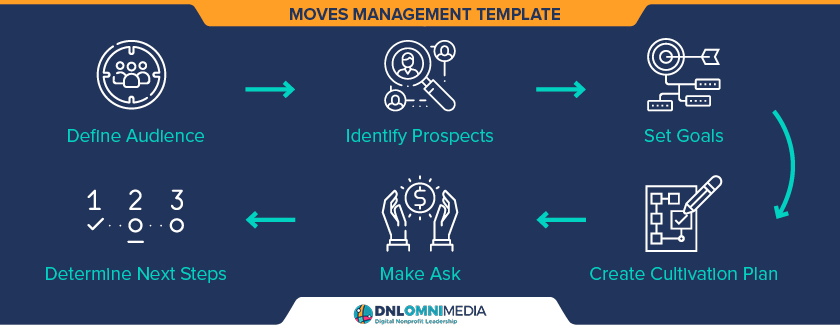
While this template can be adjusted based on each nonprofit’s needs, use it as a starting point to begin building your team’s processes.
In this example, we will examine the template through the lens of a nonprofit that is looking to secure large planned gifts. This should provide an overview of how the template is used in general and can facilitate moves management for a specific goal.
Step 1: Define your target audience.
First, you have to determine which prospects you will use your moves management strategy to cultivate relationships with. Choose these donors based on your current goal. In this example, the objective is to find current supporters who have the potential to become major planned donors.
With your goal in mind, consider who the ideal prospect to meet that goal would be and create prospect personas that embody what that supporter would look like. For example, you might track older prospects for a planned giving effort or prospects that are well-connected in your community for major capital campaign contributions.
For our planned giving example, our audience is prospects in their 50s and 60s with a strong philanthropic history and displayed interest in our cause.
Some organizations work with consultants to identify their ideal audiences. These consultants can use market research and draw on their years of experience to construct personas of your target audience. Then, they can help you sort through your donor database to find prospects that fit this audience.
Step 2: Identify and analyze prospects that fit your audience.
Use the prospect persona you created in the last step to discover ideal candidates in your database. Most often, these will be supporters who have a history with your organization. If you need to connect with more entirely new candidates, consider how you can refine your marketing strategy to attract these prospects.
Regardless, consider the following for each prospect:
- What is their current relationship with your nonprofit?
- What was the last communication between your nonprofit and the prospect?
The goal at this step is to identify prospects, gauge their potential to become major donors, and understand where they already lie in the giving cycle.
In our planned gift scenario, we would highlight prospects in the right age range, who have a long-standing relationship with the organization, and have made at least one large gift to the nonprofit in the past. Note that you should only use qualifiers such as “large” during initial planning, and assign a specific quantitative amount to it when analyzing donors.
Step 3: Set goals for the identified prospects.
At this point, your major gifts team should establish a specific strategy for each identified prospect.
For example, for your planned giving campaign, you have highlighted a 65-year-old male with a long history of volunteering with your nonprofit and an expressed interest in giving in large amounts. After conducting wealth screening, you identify that he has the potential to make a $15,000 – $20,000 financial gift in the future. As such, this amount would then be the fundraising goal for this specific donor.
Goals for prospects should be quantitative and measurable. Instead of simply wanting to secure a planned gift, get specific about what the ideal gift would look like, such as the amount, method, and pledge date. This process is repeated for each prospect.
Step 4: Create a plan for cultivating your prospects.
Create a relationship cultivation plan for each donor. This plan should include:
- The actions your team will take to steward the donor. For example, calling the donor, scheduling lunch meetings, and sending thank-you and marketing emails.
- A timeline in which those actions should take place. This could be one month, three months, six months, or longer depending on your goal.
- A check-in process after each action is complete. Who should your team members check in with after a task has been completed? Is there a system in which they should log notes? Configure your CRM to make tracking donor interactions easy for your major gift team. If your CRM needs further customization to streamline this workflow, consider working with a nonprofit technology consultant.
- Benchmarks that determine what the next steps would be. If a prospect responds in a positive (or negative) way, what are the next steps? These benchmarks should be documented in your CRM. This allows major gift officers to manage multiple donor relationships at once without disruption.
For our planned giving prospect, this plan could be a phone call, a thank-you gift basket, a lunch meeting, and a facility tour with a board member—all conducted over the course of three months and with routine check-ins for the rest of the donor’s life.
Established plans should be documented in your CRM and shared with members of your major gifts team. This allows members of the team to take on donor prospects without interruption if there is turnover, new hires, or major giving candidates need to be reassigned for any other reason.
Step 5: Make your ask.
After creating a prospect cultivation program, your team’s next step is to carry it out. After stewarding that prospect, major gift officers will need to assess when the donor is likely to be receptive to a fundraising request and make the gift ask.
These gift asks will need to be tailored to the specific donor. Rather than the donation request template you use with low- and mid-level donors, these fundraising asks should reflect the many specific steps and touchpoints your nonprofit has had with this prospect leading up to that point.
With our planned giving scenario, this would occur after the three-month timeline has played out with a positive reaction and indicators of growing interest from the prospect.
Step 6: Determine the next steps.
The final step occurs after you have made the ask. The next step in the process is determined by whether the prospect accepted or declined your fundraising request.
For either outcome, consider:
- How to continue engaging prospects-turned-donors or re-engage prospects that did not convert
- Ideas to improve your moves management strategy overall to address challenges that arose
This is where you consider what worked, what did not, and make adjustments accordingly. Use the data recorded in your CRM to assess the donor’s responses to various interactions, and use this information to identify trends across multiple donation prospects.
With our planned giving scenario, if you secured the gift, you would outline steps to continue stewarding that donor going forward until the time of their gift. If the request was rejected at this time but the donor indicated they may reconsider in the future, you may continue with cultivation. If the donor outright denied the request, you may drop engagement efforts to that of a normal donor.
Moves Management Best Practices
When designing your moves management strategy, an outline like the one provided in our template is a useful starting point. However, the actual best practices your team uses when meeting with donors and implementing your strategy are what make all the difference.
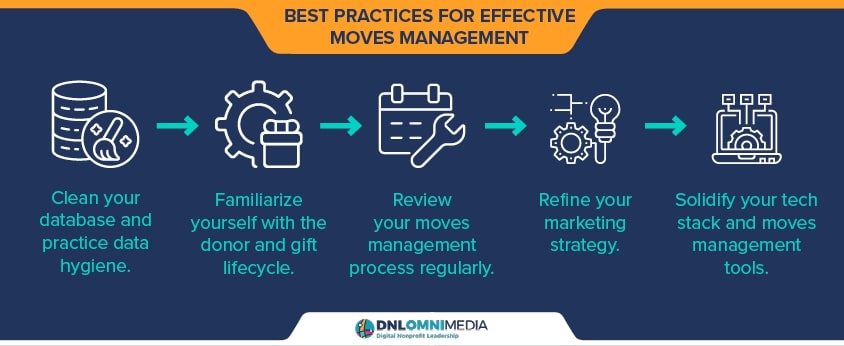
Clean your database and practice data hygiene.
The goal of moves management is to gain insight into every step of the giving cycle. Each move should be recorded and tracked in your nonprofit’s CRM system as data.
This means effective moves management requires accurate, clean data. This comes down to having strong data hygiene procedures, including:
- Conducting an initial database clean-up. If your organization has not been prioritizing database management, you likely have inaccurate, duplicate data. An initial clean-up ensures you start with a strong foundation and remove any obviously incorrect information.
- Creating standardized procedures for data entry. Data hygiene is an ongoing process. Create standards surrounding how commonly mistaken terms should be entered, such as the styling of addresses, phone numbers, and titles. Additionally, implement procedures for identifying and handling duplicate and incorrect data entries. Some CRMs have add-ons and apps that can help manage these processes for you.
- Outlining standards around which moves need to be reported and when. Moves management involves constantly tracking all actions taken with donors. Create standards surrounding which moves need to be recorded, as well as when and how, to ensure all prospects are tracked in a uniform manner.
Once these standards are set, communicate them across your entire team. This will ensure that all data surrounding your moves management strategy is recorded in an accurate, helpful way.
Familiarize yourself with the donor and gift lifecycle.
Moves management is built on the donor and gift lifecycles. As a nonprofit development professional, you are probably already familiar with the stages involved. For a quick refresher, take a look over this infographic of the donor and gift lifecycles:
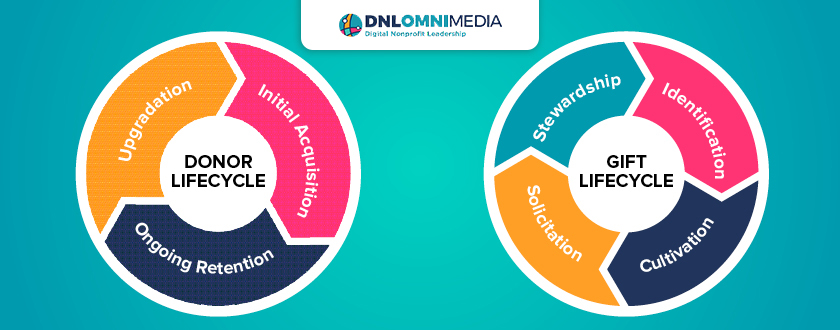
In the donor lifecycle, the steps are:
- Initial donor acquisition is when the donor makes their first gift to your organization.
- Ongoing retention occurs anywhere from the first few months to the first few years of the donor’s relationship with your nonprofit, as their connection to your organization grows.
- Donor upgradation is when the donor continues giving and starts to do so in higher amounts than before, transitioning into a lifelong giving relationship.
Additionally, it is important to understand the lifecycle of securing a specific gift:
- Identification is when you discover a prospective gift.
- Cultivation is when you cultivate a relationship with that prospect.
- Solicitation is when you solicit a gift from that prospect.
- Stewardship is when you continue building a relationship with the donor after they have given.
How you engage prospects depends on where they are in both cycles. For example, you would steward a prospective first-time donor differently than a donor who has already upgraded to making larger gifts. Similarly, you pursue gifts in the cultivation stage much differently than in the stewardship phase.
Review your moves management process regularly.
In addition to reviewing your moves management strategy after you’ve cycled a prospect through it, you should also regularly check in on the progress of prospects while they are actively being tracked. This review will ensure all opportunities and challenges are discovered and acted on quickly and efficiently.
For example, you may discover that a prospect has indicated that they are interested in making an even bigger gift than initially anticipated. In that case, you would adjust your strategy to usher that larger gift to completion. On the other hand, if you discover that a prospect was thrown off by a cultivation tactic that your team employed, it may be necessary to conduct damage control to secure the relationship.
Discovering these situations as early as possible is vital. The easiest way to do so is to set frequent benchmarks to assess progress along the way, such as event attendance, responsiveness to messages, and current donation amounts.
At each benchmark, consider:
- Is the prospect progressing as originally planned?
- If not, what is inhibiting them from doing so?
- What can your team do to overcome that obstacle?
- Is the prospect further along than expected?
- What can your team do to make the most of this opportunity?
Moves management is not a one-size-fits-all process, and the chances of securing a gift can change day by day. Keep careful track of your data to help your major gifts team coordinate and seek help from one another.
Refine your marketing strategy.
The first step in securing a major gift is attracting and retaining donors with the potential to become major donors. Marketing is your strongest tool for casting a wide net to find these donors and encourage them to continue giving to your nonprofit long enough for your major gift team to identify them as a major giving prospect.
Additionally, the marketing strategies you use will inform these donors’ impressions of your nonprofit and enable them to build a relationship with your organization before your major gift team does so formally.
A few marketing strategies to consider implementing include:
- Use ad retargeting. Re-targeted ads are ads for your nonprofit that appear on websites supporters visit after they abandoned an action related to your nonprofit, like exiting a donation page before completing their gift. These keep your nonprofit front and center in their minds and can help you connect with prospective supporters who may have initially lapsed before becoming donors.
- Create memorable marketing materials. Your external communication materials and content throughout your entire donor cultivation process should stand out. For new donors, this might involve eye-catching graphics on social media, while you might send elaborate thank you messages, such as eCards, to donors you have an established relationship with.
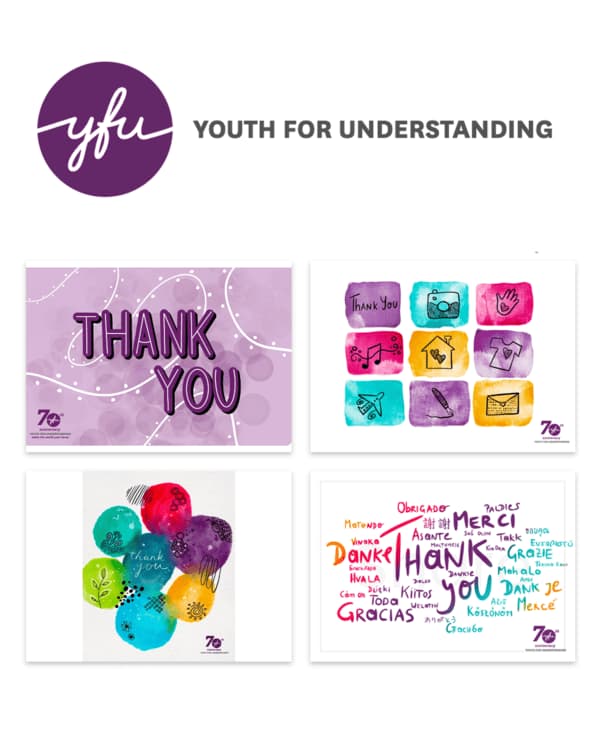
- Personalize communication. Major gift officers will create personalized communication plans as part of their donor stewardship strategy. However, even before prospective donors move to this phase, ensure your communication is tailored to their interests and addresses them personally.
One communication channel to consider for casting a wide net of support is Google Ads. Google dominates 91% of the search engine market, meaning it is the go-to search tool for approximately 9 in 10 of your supporters.
While it is unlikely a Google Ad will cause a supporter to become a major donor, it can be a useful tool for earning new donors, who may have the potential to become major donors down the road. In particular, the Google Ad is a useful and accessible marketing tool for nonprofits due to the Google Ad Grant program, which provides nonprofits with free advertising credits.
With an additional marketing channel that is free to use, your nonprofit can expand its reach and find even more donors who may one day become major giving candidates.
Solidify your tech stack and moves management tools.
Each step of the moves management process is tracked using technology. It is crucial that the various nonprofit tech tools you use to connect with donors are working in sync.
Some nonprofits may choose to bring in a consultant to help with their technology. For example, Team DNL works with mid-sized to large nonprofits to implement and improve their technology stacks in preparation for effective moves management.
Consultants can help with numerous processes, such as building seamless integrations, conducting data hygiene reviews, completing CRM updates, managing complete data migrations, and assisting with other database customizations with the goal of effective moves tracking. Whether you are using a robust solution such as those offered by Blackbaud or Salesforce, or a smaller CRM, it can be valuable to bring in an expert outside opinion.
Moves management is a highly strategic effort and to be effective, your team and your technology need to work in sync. To learn more about how Team DNL can help position your tech stack to empower your moves management strategy, contact us today.
For more tips on how to use technology to strengthen your fundraising strategies, check out the following additional resources:
- Nonprofit Technology: Why, What & How of Smarter Fundraising. Technology is integral to successful fundraising. Explore the many solutions available to your team in this guide.
- Nonprofit Email Marketing: The Ultimate Guide for Online Engagement. Is your team considering incorporating email marketing in your outreach? Check out this guide to improve your strategies.
- Apps for Nonprofits: Top Tips and Providers for Your Mission. Apps are the latest development when it comes to innovative nonprofit technology. Learn all about nonprofit apps and mobile engagement here.

